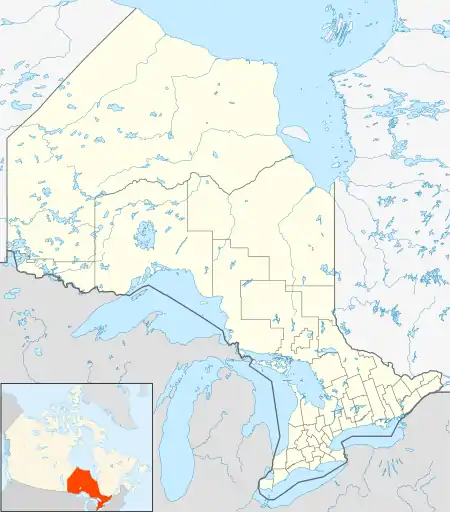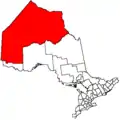Neskantaga First Nation
Neskantaga First Nation (formerly known as Lansdowne House Indian Band) is a remote Oji-Cree First Nation band government in the northern reaches of the Canadian province of Ontario, situated along the shore of Attawapiskat Lake in the District of Kenora.
Neskantaga | |
|---|---|
| Neskantaga Indian Reserve | |
 Neskantaga | |
| Coordinates: 52°12′N 88°02′W | |
| Country | |
| Province | |
| District | Kenora |
| First Nation | Neskantaga |
| Area | |
| • Land | 8.30 km2 (3.20 sq mi) |
| Population (2016)[2] | |
| • Total | 237 |
| Website | neskantaga.com |
The First Nation is a signatory to Treaty 9 (originally as part of the Fort Hope Band) and has reserved for itself the 831.50 hectares (2,054.7 acres) Neskantaga Indian Reserve, containing the main community of Lansdowne House Indian Settlement on Attawapiskat Lake. Associated with the Neskantaga First Nation is the Summer Beaver Indian Settlement, which is shared with Nibinamik First Nation. The Lansdowne House is linked to the rest of Ontario by the Lansdowne House Airport, and by winter roads and ice roads to points south, via the Northern Ontario Resource Trail. As of November 2011, there is a total registered population of 414 people, of whom 304 people live on their own reserve.
Neskantaga is a fly-in community and is therefore not accessible by road.
Northern Light Mission Trips have been conducted for the children of the community by members of the Tintern Church of Christ in Beamsville, Ontario.
Governance
The First Nation elects its officials under the Custom Electoral System. The most recent officials were Peter Moonias as Chief, and Bill Mequanawap, Christopher Moonias, Kelvin Moonias and William Moonias as Councillors; their two-year term ended on 03/31/2013.
The First Nation's council is a member of the Matawa First Nations, a local Chiefs Council, and of Nishnawbe Aski Nation, a Tribal Political Organisation representing most of the First Nations in northern Ontario.
Ring of Fire
On May 9, 2012 Ontario Minister Rick Bartolucci released the White Paper regarding the Northern Ontario Ring of Fire, including the announcement of decisions made regarding Cliffs and the province that would negatively impact Treaty 9 land. According to the Neskantaga First Nation, the agreements with Cliffs about Treaty 9 lands, was a "blatant and illegal attempt by Ontario to expand its own influence and jurisdiction in Treaty No. 9.[3] "Ontario has twice pushed back the deadline for input" in Ring of Fire planning, but the community says it has not enough time.[4]
Access to potable water
Neskantaga First Nation community has been under a "boil water advisory" since 1995, when its then-newly installed 1993 water treatment plant broke down. It gained national attention when Canadian news outlets began to cover the story from 2004 to 2016 about the unsafe water supply. In 2006, the 2005 government plan to modernize water supplies was cancelled following a change of government.[5]
In October 2020, the Neskantaga First Nation fully evacuated the reserve after test results showed high levels of hydrocarbons in the water supply.[6] On December 21, 2020, over 250 members returned to the reserve.[7]
Climate
Neskantaga First Nation has a subarctic climate (Dfc). Summers consist of mild, sometimes warm days with cool nights and rain usually falling on a little more than half of all summer days. Winters are brutally cold with nights reaching dangerously cold temperatures and annual snowfall averaging 95.1 inches, (241.6 cm) falling on 89 separate days. Winter usually begins sometime during October and can easily last well into April.
| Climate data for Neskantaga First Nation (1971−2000) | |||||||||||||
|---|---|---|---|---|---|---|---|---|---|---|---|---|---|
| Month | Jan | Feb | Mar | Apr | May | Jun | Jul | Aug | Sep | Oct | Nov | Dec | Year |
| Record high humidex | 2.7 | 9.9 | 17.2 | 25.0 | 44.5 | 40.9 | 44.5 | 40.7 | 32.8 | 25.4 | 16.1 | 7.1 | 44.5 |
| Record high °C (°F) | 3.3 (37.9) |
9.9 (49.8) |
15.6 (60.1) |
25.6 (78.1) |
32.8 (91.0) |
35.0 (95.0) |
36.7 (98.1) |
35.0 (95.0) |
29.4 (84.9) |
24.4 (75.9) |
17.2 (63.0) |
7.2 (45.0) |
36.7 (98.1) |
| Average high °C (°F) | −16.9 (1.6) |
−12.3 (9.9) |
−4.4 (24.1) |
4.8 (40.6) |
13.5 (56.3) |
18.9 (66.0) |
22.4 (72.3) |
20.5 (68.9) |
13.0 (55.4) |
5.8 (42.4) |
−3.7 (25.3) |
−13.7 (7.3) |
4.0 (39.2) |
| Daily mean °C (°F) | −22.3 (−8.1) |
−18.8 (−1.8) |
−11.8 (10.8) |
−1.6 (29.1) |
7.3 (45.1) |
13.5 (56.3) |
17.2 (63.0) |
15.6 (60.1) |
8.9 (48.0) |
2.4 (36.3) |
−7.2 (19.0) |
−18.5 (−1.3) |
−1.3 (29.7) |
| Average low °C (°F) | −27.7 (−17.9) |
−25.2 (−13.4) |
−19.2 (−2.6) |
−8.1 (17.4) |
1.2 (34.2) |
8.1 (46.6) |
12.0 (53.6) |
10.7 (51.3) |
4.8 (40.6) |
−0.9 (30.4) |
−10.6 (12.9) |
−23.2 (−9.8) |
−6.5 (20.3) |
| Record low °C (°F) | −47.8 (−54.0) |
−45.6 (−50.1) |
−42.8 (−45.0) |
−32.8 (−27.0) |
−17.2 (1.0) |
−4.4 (24.1) |
0.6 (33.1) |
1.1 (34.0) |
−7.2 (19.0) |
−15.6 (3.9) |
−33.4 (−28.1) |
−43.3 (−45.9) |
−47.8 (−54.0) |
| Record low wind chill | −57.6 | −58.3 | −50.4 | −41.3 | −26.8 | −7.9 | −4.4 | −1.8 | −15.5 | −21.8 | −44.2 | −52.5 | −58.3 |
| Average precipitation mm (inches) | 26.6 (1.05) |
21.8 (0.86) |
31.6 (1.24) |
41.9 (1.65) |
50.7 (2.00) |
80.8 (3.18) |
107.5 (4.23) |
102.7 (4.04) |
92.6 (3.65) |
56.6 (2.23) |
54.8 (2.16) |
32.1 (1.26) |
699.5 (27.54) |
| Average rainfall mm (inches) | 0.0 (0.0) |
0.2 (0.01) |
3.3 (0.13) |
19.9 (0.78) |
43.3 (1.70) |
79.3 (3.12) |
107.5 (4.23) |
102.7 (4.04) |
88.8 (3.50) |
34.1 (1.34) |
8.6 (0.34) |
1.0 (0.04) |
488.7 (19.24) |
| Average snowfall cm (inches) | 31.3 (12.3) |
26.5 (10.4) |
33.0 (13.0) |
24.2 (9.5) |
8.0 (3.1) |
1.6 (0.6) |
0.0 (0.0) |
0.0 (0.0) |
3.9 (1.5) |
24.0 (9.4) |
51.2 (20.2) |
38.0 (15.0) |
241.6 (95.1) |
| Average precipitation days (≥ 0.2 mm) | 13.0 | 11.6 | 11.2 | 9.5 | 11.8 | 15.0 | 16.0 | 15.8 | 17.7 | 15.8 | 15.9 | 15.5 | 168.9 |
| Average rainy days (≥ 0.2 mm) | 0.0 | 0.21 | 1.5 | 4.2 | 10.1 | 14.9 | 16.0 | 15.8 | 16.9 | 9.7 | 2.2 | 0.28 | 91.8 |
| Average snowy days (≥ 0.2 cm) | 13.3 | 11.9 | 10.6 | 6.8 | 3.2 | 0.53 | 0.0 | 0.0 | 1.8 | 9.3 | 15.2 | 16.2 | 88.7 |
| Source: Environment Canada[8] | |||||||||||||
References
- "Neskantaga census profile". 2011 Census of Population. Statistics Canada. Retrieved 22 June 2015.
- "Neskantaga census profile". 2016 Census of Population. Statistics Canada. Retrieved 22 June 2015.
- "A New Deal for First Nations and the North". Neskantaga First Nation. May 9, 2012. Archived from the original on 2012. Retrieved October 23, 2018.
- Maclean's Magazine, January 2021, p.27."
- https://www.theglobeandmail.com/news/national/unresolved-water-advisories-in-aboriginal-communities-creating-a-health-emergency/article27627801/
- "Lansdowne House". Canadian Climate Normals 1971–2000. Environment Canada. Archived from [climate.weather.gc.ca/climate_normals/results_e.html?searchType=stnProv&lstProvince=ON&txtCentralLatMin=0&txtCentralLatSec=0&txtCentralLongMin=0&txtCentralLongSec=0&stnID=3919&dispBack=0 the original] Check
|url=value (help) on July 3, 2019. Retrieved July 3, 2019.
